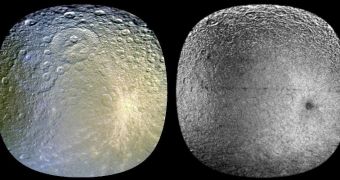Experts from NASA announce that new data on Saturn's inner moons seem to indicate that the large amount of scars they have on their surfaces was produced by a cosmic bombardment.
These cosmic events mostly affected the gas giant's inner, mid-sized moons, including Mimas, Enceladus, Tethys, Dione and Rhea. All of them have icy surface, so the scars are clearly visible.
They all display reddish and bluish hues on their surfaces, and the investigators say that these features are due to cosmic impacts of varying intensities and sizes.
But a new scientific paper on the issue would seem to indicate that other factors might be at work too. The study appears in the latest online issue of the esteemed scientific journal Icarus.
The investigators behind it look at the intricate network of connections that formed between these moons, Saturn's magnetic field, and the gas giant's outer ring (the E Ring).
All of them exchange materials, or contribute to influencing the patterns in which material is distributed within this system. Analyzing this could shed more light on the massive planet.
A Cassini data analysis program grant was used to support this research, which was conducted by Lunar and Planetary Institute in Houston expert Paul Schenk. He is also the lead author of the paper.
“The beauty of it all is how the satellites behave as a family, recording similar processes and events on their surfaces, each in its own unique way,” the expert argues.
“I don't think anyone expected that electrons would leave such obvious fingerprints on planetary surfaces, but we see it on several moons, including Mimas, which was once thought to be rather bland,” Schenk goes on to say.
The research group investigated images that were collected by the NASA Cassini orbiter between 2004 and 2009. They then assembled the photos in composite images, that painted maps of the five moons.
“The richness of the Cassini data set – visible images, infrared images, ultraviolet images, measurements of the radiation belts – is such that we can finally 'paint a picture' as to how the satellites themselves are 'painted',”explains expert William B. McKinnon
The scientist, who holds an appointment at the Washington University in St. Louis (WUSTL), is one of the six coauthors of the new research paper.
The Cassini-Huygens mission is a joint project of NASA, the European Space Agency (ESA) and the Italian Space Agency.
The American portion of the mission is managed by the NASA Jet Propulsion Laboratory (JPL), a division of the California Institute of Technology, in Pasadena.

 14 DAY TRIAL //
14 DAY TRIAL //